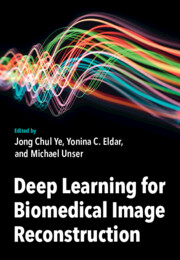Book contents
- Frontmatter
- Dedication
- Contents
- List of Contributors
- Preface
- Part I Theory of Deep Learning for Image Reconstruction
- 1 Formalizing Deep Neural Networks
- 2 Geometry of Deep Learning
- 3 Model-Based Reconstruction with Learning: From Unsupervised to Supervised and Beyond
- 4 Deep Algorithm Unrolling for Biomedical Imaging
- Part II Deep-Learning Architecture for Various Imaging Architectures
- Part III Generative Models for Biomedical Imaging
4 - Deep Algorithm Unrolling for Biomedical Imaging
from Part I - Theory of Deep Learning for Image Reconstruction
Published online by Cambridge University Press: 15 September 2023
- Frontmatter
- Dedication
- Contents
- List of Contributors
- Preface
- Part I Theory of Deep Learning for Image Reconstruction
- 1 Formalizing Deep Neural Networks
- 2 Geometry of Deep Learning
- 3 Model-Based Reconstruction with Learning: From Unsupervised to Supervised and Beyond
- 4 Deep Algorithm Unrolling for Biomedical Imaging
- Part II Deep-Learning Architecture for Various Imaging Architectures
- Part III Generative Models for Biomedical Imaging
Summary
In this chapter, we review biomedical applications and breakthroughs via leveraging algorithm unrolling, an important technique that bridges between traditional iterative algorithms and modern deep learning techniques. To provide context, we start by tracing the origin of algorithm unrolling and providing a comprehensive tutorial on how to unroll iterative algorithms into deep networks. We then extensively cover algorithm unrolling in a wide variety of biomedical imaging modalities and delve into several representative recent works in detail. Indeed, there is a rich history of iterative algorithms for biomedical image synthesis, which makes the field ripe for unrolling techniques. In addition, we put algorithm unrolling into a broad perspective, in order to understand why it is particularly effective, and discuss recent trends. Finally, we conclude the chapter by discussing open challenges and suggesting future research directions.
- Type
- Chapter
- Information
- Deep Learning for Biomedical Image Reconstruction , pp. 53 - 86Publisher: Cambridge University PressPrint publication year: 2023
- 3
- Cited by



